-
Posts
429 -
Joined
-
Last visited
-
Days Won
1
Content Type
Profiles
Forums
Blogs
Gallery
Events
Store
Posts posted by GRA
-
-
I've found Lt M in "Sveriges Statskalender"... He's listed on page 721 in the 1915 edition as "Riddare av Kungl. Svärdsorden" (RSO), "Marchiafava, Emilio, Italiensk Löjtn., 11.", no citation. I bet earlier editions wouldn't provide citations either. Lieutenants in their thirties just doesn't walk around getting themselves random foreign decorations without someone noticing sooner or later, so there has to be an official trace somewhere... Regimental histories, perhaps?
/Jonas
0 -
Claudio,
Do you have access to Italian archives? I can only find a visit of king Vittorio Emmanuele III to Sweden in 1913... There's however an Italian politician - Giovanni Giolitti - who was awarded the Order of the Seraphim two days after Lt M got his RSO! Is there some sort of connection? Link: http://en.wikipedia.org/wiki/List_of_Knights_of_the_Order_of_the_Seraphim
/Jonas
0 -
Claudio,
If you look at this thread; http://gmic.co.uk/index.php/topic/29604-swedish-military/, you'll find examples of Swedish officers receiving the RSO 20-25 years into their careers at the rank of captain, some of them also got foreign decorations before that as orderly officers during state visits. Assuming that the Italian armed forces worked in roughly the same way, I'd say that you can apply the same pattern on Lt M.
/Jonas
0 -
After looking at an online copy of "Sveriges Statskalender", 1915 edition, I find foreign military attachés of the rank of lieutenant, but attachés with Swedish decorations are of higher rank (such as the French naval attaché, commander Jean Jules Gallaud KSO2kl - two steps up from RSO level). As far as I can see, there's no uniformed members of the Italian embassy at all in 1915. Looking at the 1905 edition, there are examples of captains with the same level of Svärdsorden as Lt M - RSO. No uniformed Italians in 1905 either. I still lean in the general direction of a state visit...
/Jonas
0 -
As to the question why: If there was a state visit just before the award date, well, there's the most probable reason. If not, it could be more complicated to find out why.
As to general information: Wikipedia (at least in Swedish) provides decent pictures of the different levels of the insignia. The current manufacturer of insignia of the royal orders are Lars Kjellander Ordensateljé.
As to the insignia on the award document: It seems like it is the insignia of the seal of Kunglig Majestäts Orden (http://www.kungahuset.se/monarkin/ordnar/kunglmajtsorden.4.367010ad11497db6cba80004760.html), thus explaining a general document and also why the Chancellor of the Orders has signed and not the king himself?
/Jonas
0 -
I wonder the same... and I wonder also why the order of Sward is written by hand in a document referring to a much higher order. Is this normal?
I don't know, but I've got the feeling that this is a standard document for pretty much anything awarded by the king of Sweden, the king would of course want a picture of his most senior award to be shown on the document! There are examples of senior Swedish regiments carrying the Order of the Seraphim regalia on their colours and standards, not because they were awarded the decoration as such, but because of seniority.
I wonder whether the award was made because of a state visit in either Sweden or Italy, a "for bravery with the briefcase"-award? A mere lieutenant seems too junior for a military attaché appointment...
/Jonas
0 -
The document states that the Italian lieutenant Emilio Marchiafava is appointed knight, 2nd class, of The Royal Order of the Sword (Swedish abbreviation RSO - knight of the Order of the Sword).
There's no way he could have been awarded the Order of the Seraphim - no royal blood and way too low in the chain of command. This is the normal level that was then awarded to Swedish officers after ~25 years of service, I wonder why your Italian lieutenant got the RSO?
/Jonas
0 -
Can anyone tell me where I might find a TOTAL listing of all WW II Armored Divisions? I have seen patches with numbers in the high 700s.
Thanks
Hello Ed!
I'm sure Dave has a better reference library than me, however, a quick look into "US Armor-Cavalry - A Short History 1917-1967" (Duncan Crow) yield the following:
Armoured divisions; 1st-14th, 16th, 20th
Separate tank battalions (non-divisional); 44th, 46th, 70th, 191st-194th, 701st, 702nd, 707th-714th, 716th, 717th, 735th-741st, 743rd-763rd, 766th, 767th, 771st-778th, 780th-782nd, 784th, 786th, 787th, 798th
Tank destroyer battalions were numbered in the 600, 700 and 800 series with the exception of the 85th Bn.
Expect renumbering from original numbers in some cases...
Do you want to know to which armoured division the divisional tank battalions belonged?
/Jonas
0 -
Another company symbol...
The Älvsborg Regiment made up a set of company flags sized 60cmX80cm for informal barracks use. Sets of miniature flags for table use were also produced, these could be seen in offices and expeditions all over the regiment as well as among the volunteer organisations. The different company flag designs can be seen in post #2 above.
This particular flag from Marks kompani were never issued (see the creases!), I am in fact not sure this company's flag were ever used, the company were rarely organised during the time these flags were in use. After the regiment disbanded I saw a box full of these company flags, brand new and in bags, waiting to be included in the regimental museum collection (at least I hope so!), noting that there were doubles in the box, I asked the person in charge of the collection if there was any possibility for one of these company flags to come to a caring home. As my great-great-grandfather served for thirty years in that company, the choice of flag was easy!
/Jonas
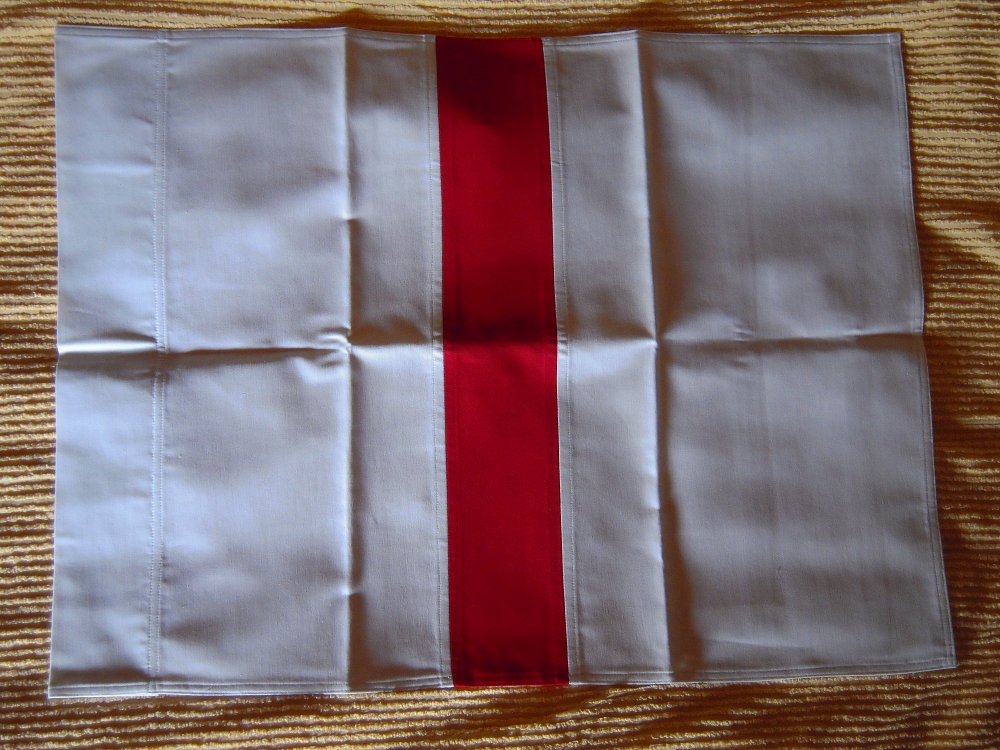 0
0 -
The old county regiments were also responsible for the defence of a part of the Swedish territory, a "Defence Area" - Försvarsområde (Fo) - and part of the organisation was made up of the Home Guards. The first patch design were basically the same as the regimental patch, but with a blue border and a tab above denoting the particular Home Guard sub-units ("battalion-sized", but in reality weaker).
The first design; A selection of sub-units from different towns and administrative areas, this selection is basically a complete set from the southern part of Fo34 (Defence Area 34) with one tab (Vänersborg) from the northern part. The Driftvärnet tab would have been worn by Home Guards members assigned to the protection of certain essential objects such as power plants, they would normally work on the object in question in peacetime too.
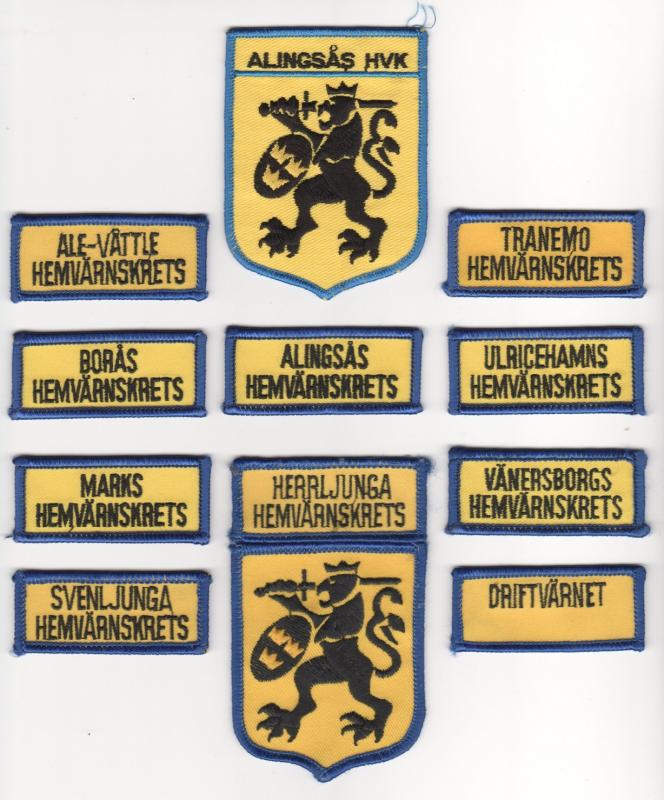
The last design; Defence Area HQ (newer manufacture), Home Guards (a generic design for all Home Guards units, after 1998 the sub-unit design made a comeback - after the regiment disbanded).
 0
0 -
The Älvsborg Brigade also had a series of patches for its wartime organisation, as can be seen, it is of the same design as the Basic Training Battalion but with yellow half-lions instead of half-lions whose colours were based on the company name-tag colours.
Top; Älvsborg Brigade
Center; Brigade HQ (newer manufacture), Brigade HQ Coy
Bottom; Brigade Recce Coy, Brigade Anti-Aircraft Coy (trained by 6th AA Regt?)
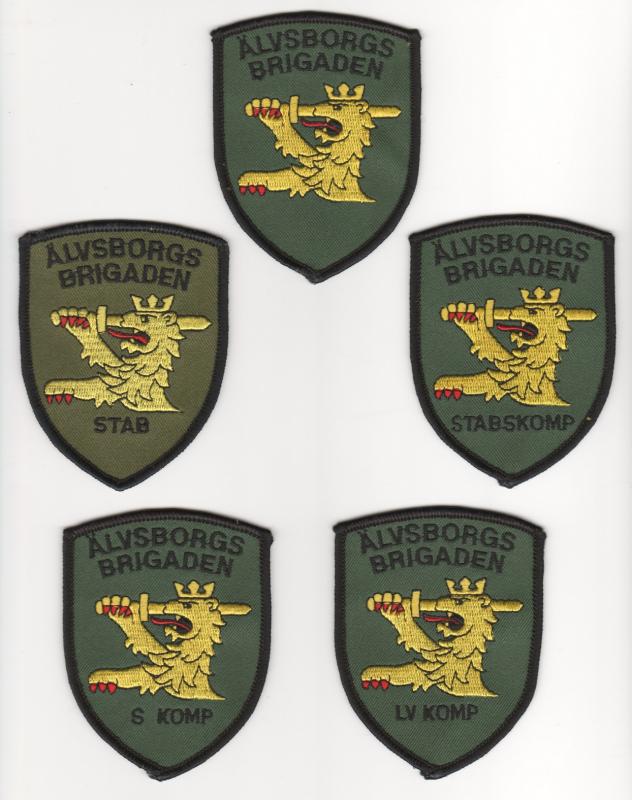
Brigade Rifle Battalions (1.-4.)
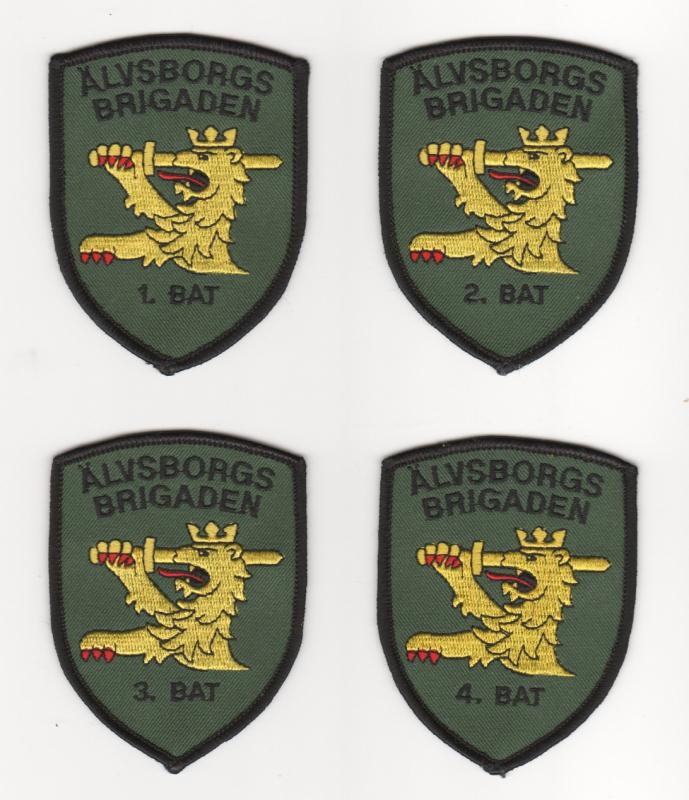
Top; Brigade Anti-Tank Coy, Brigade Tracked Anti-Tank Coy (12x Ikv 91 tank destroyers + 1x mounted rifle platoon, trained by 4th Armoured Regt)
Center; Brigade Howitzer Battalion (trained by 9th Artillery Regt), Brigade Pioneer Battalion
Bottom; Brigade Service & Supply Battalion
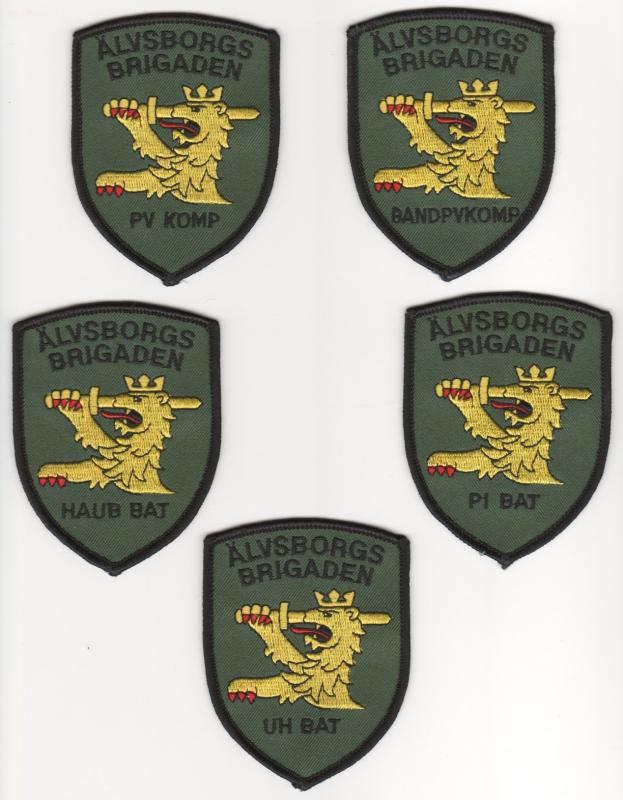 0
0 -
I have no idea of the value, but since Swedish Red Cross is by no means a small organisation, this being their "entrance award" and this particular award having been around for almost 70 years, it'll probably be quite common. Some of the Swedish volunteer organisations medals on this level (national) and lower (regional) are made of silver, the S in SRKSFt means a silver-level award. I have a couple of gold-level awards myself that is gilt 925-silver as well as silver-level in 925-silver. Are there any stamps?
/Jonas
0 -
Hello Robert!
What you have is the Swedish Red Cross commendation award - Svenska Röda Korsets förtjänsttecken (SRKSFt) - dating from 1944. It's the first step of the medals awarded by the Swedish Red Cross and is awarded "for a minimum of five years of dedicated work".
/Jonas
0 -
Perhaps something worn from the neck? It doesn't look like the kind of case used for orders/medals worn on the breast, and the top white section looks like it could accommodate a neck ribbon.
/Jonas
0 -
Hello Mikko!
Lars Kjellander is apparently a former employee of Carlmans who started his own firm fifteen years ago and are now manufacturing and repairing Swedish orders and medals. Try googling "ordensjuvelerare Lars Kjellman" and you'll find more information (if you don't understand Swedish try Google Translate, it translates well enough to make you understand most of it).
/Jonas
0 -
Are you sure Mike? The Yorkshire Dragoons badge lack the feathers and the motto, but it fits very vell with the Yorkshire Hussars (Alexandra, Princess of Wales's Own)... Source: The Yeomanry Regiments (Mileham, 3rd ed 2003) and own files.
/Jonas
0 -
You can find some more Bundeswehr company patches here http://gmic.co.uk/index.php/topic/54016-bundeswehr-unit-patches/#entry494151, including two more patches from PzGrenBtl72. Your 2./PzGrenBtl72 patch certainly looks like the company badge found here https://www.facebook.com/media/set/?set=a.185112778285754.40942.184780184985680&type=3. The battalion existed 1959-2003.
/Jonas
0 -
According to "Battle Honours of the British and Commonwealth Armies" (Baker, 1986), the following British regiments were present at El Bodon (25th Sep 1811): 11th Light Dragoons, 5th (2nd Bn), 60th, 74th, 77th and 83rd Foot. Of these regiments, the 11th LD, 5th and 77th Foot all applied for the battle honour (the 11th LD were refused in 1838). All regiments above were entitled to the Peninsula battle honour, but only the 11th Light Dragoons were present at Waterloo and awarded that battle honour.
Now, that's the ethnic British units, but there's also the King's German Legion... The 1st Regiment of Hussars of the King's German Legion also fought at El Bodon, according to Wikipedia they were awarded the battle honour for it (the only unit within the KGL awarded that battle honour) and presumably also the Peninsula battle honour. They were also present at Waterloo...
How does all this fit in with the George V cypher??? The 11th Hussars seemed to have different battle honours in their design... I'm really curious as to which unit used this pouch!
/Jonas
0 -
It says "For Bravery" (at least in Swedish), and the medal ought to be the Medal of Liberty, 2nd Class. Now, the really interesting question is how it could end up on that ribbon bar?
/Jonas
0 -
The collar dogs looks a lot like Czechoslovak 1st republic mountain troops (see link: http://en.valka.cz/viewtopic.php/t/28791), but I'm not sure about the rest of the uniform.
/Jonas
0 -
Hi all I have this BRD visor which I don't recognise the waffenfarbe colour, could anyone enlighten me, any help appreciated, best regards
Alex K
It looks like the ABC-Abwehrtruppe.
/Jonas
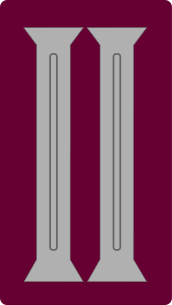 0
0 -
I think Peter means one of these. Just remove your ribbons from the single slides and put them on a 2X-slide instead.

/Jonas
0 -
Hello Robin!
It's a Swedish pin, the "komp" is a common Swedish military abbreviation for kompani - company. In this case it is the motorcycle company of the 10th Armoured Brigade, see link: http://www.beredskapsmaerken1939-1945.se/pansar.htm
/Jonas
0 -
Are you sure? I also have this photo. It is writte with "Swedish soldiers" I think, it is the same uniform
These guys (#2 - rank? and #5 - captain?) are Swedes, but there are no Swedes in the original picture in post #1!
/Jonas
0




Memento Mori
in Non Military Collectibles & Antiques
Posted
As I recall when visiting the Sedlec Ossuary in Kutna Hora (Czech Republic), the bodies were exhumed and then treated to get rid of whatever flesh that may still have been left and give the skeleton a whiter colour. Personally, I wouldn't call it bizarre, but it was definitely a visit to remember.
/Jonas